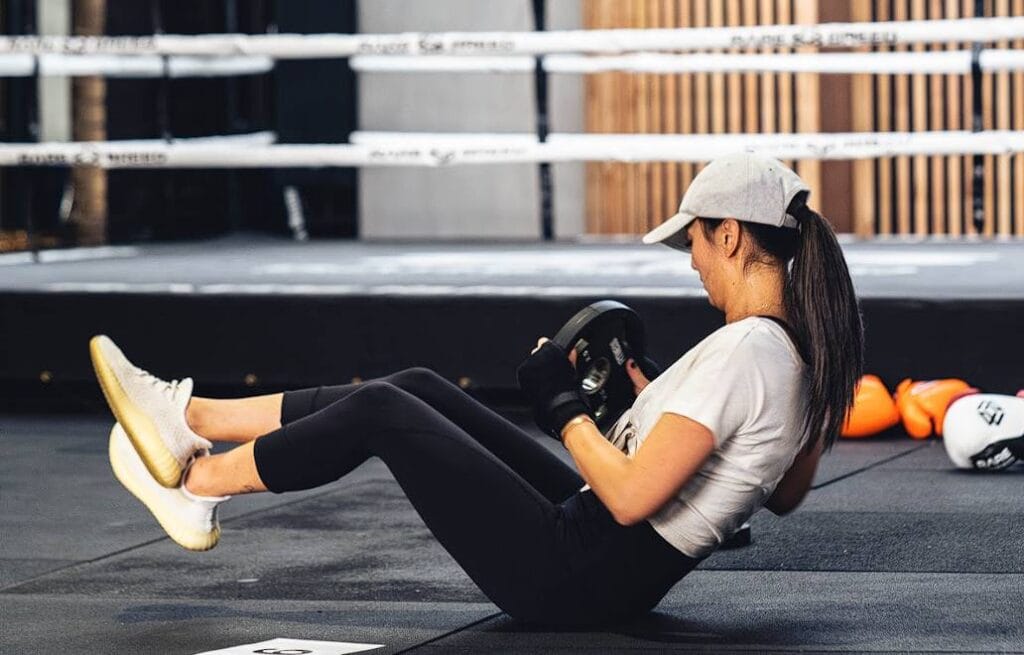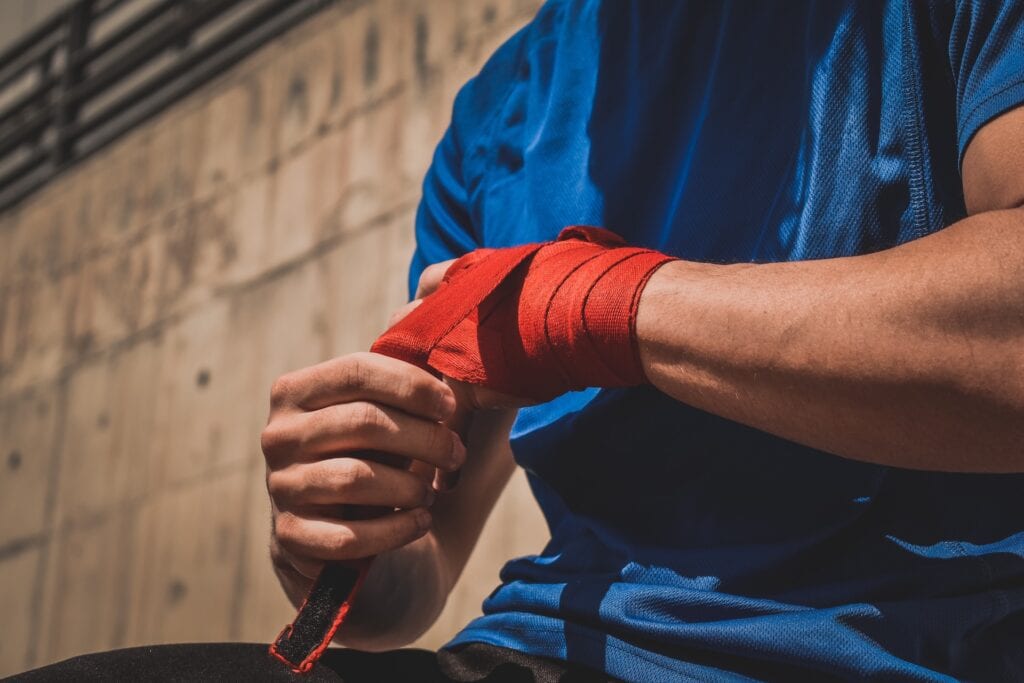Boxing is one of the most difficult but also one of the most efficient forms of exercise. As a result, professional boxers, at the peak of their careers, are among the fittest athletes in the world.
To take advantage of boxing's positive effects on physical fitness, you don't have to spar with other people or be a professional boxer. Instead, regular heavy bag exercises, speed bag drills, and shadowboxing can get you in fantastic shape without requiring you to step inside a ring at any point in the process.
Boxing is a great way to get in shape and to become a lean, mean fighting machine like Floyd Mayweather and the other champion fighters. You need to balance your boxing routines with strength training and conditioning.
Exercises that develop your strength, agility, speed, endurance, and power are some of the finest workouts for boxers outside the boxing-specific drills they already do. Boxing is a high-intensity, anaerobic sport with aerobic demands.
Consequently, cardio and conditioning exercises are important components of boxing workouts. Because boxing requires cardiovascular endurance and metabolic conditioning, it is a sport that combines anaerobic and aerobic demands.
Boxing is considered a total-body sport because the power behind a punch originates from the hips, the core, and the lower body, contrary to the common misconception that boxing only involves the upper body and its associated muscles.
Consequently, the most effective boxing workouts will incorporate strengthening exercises that target all the major muscles in the body and educate your neuromuscular system to coordinate movements and muscle contractions to produce more force and power.
So continue reading for the best strengthening and conditioning workout for boxers, which will take your boxing to the next level and help you channel your inner Muhammad Ali.
16 Basic Boxing Tips
Here is a quick list of 16 basic boxing tips your trainer should have told you. These boxing tips will improve your boxing training, punching, and defence. Good luck!
- Stay calm and punch lighter on the bag to last more rounds, keep your form together, and punch sharp. It will allow you to get more quality bag work. You want the energy to hit the bag with the correct form and keep your punches snappy instead of wasting panting and huffing to show that you have a heart.
- Don’t work out till complete failure. Get tired, break a sweat, and push yourself a little more each day. If you go to failure every day of the week without reason, you’ll probably overtrain and quit boxing very soon.
- Drink lots of water. One cup every hour, minimum!
- Make friends in the gym, be humble, and ask people for boxing tips. Then, when another boxer beats you, ask him how he did it. You may be surprised at how helpful he might show you your weaknesses.
- Turn your whole body into the punch. If your feet are slow, you will find that punching slower hits harder than punching faster. So, punch as fast as your body can turn so you won’t sacrifice power.
- Throw short hooks, short uppercuts, and short rights but long jabs.
- You don’t always have to throw one knockout punch after another. Combo light and hard punches and use head movement to fake out your opponent. Remember that the harder you try, the harder they will counter, and the harder you will get hurt. So calm down and throw the hard punches when you know they’ll land.
- Remember to go to the body. Try a jab to the head and a right hand to the body. When you’re close, lean your head inside to smother him and throw 2-3 body punches.
- Throw a maximum of three to five punch combos. You do not require 10-punch combinations because they drain your energy and leave you vulnerable to countermeasures. So don't even bother practising these for the time being.
- When you punch, exhale completely and keep your eyes on your intended target. Remember to breathe normally and keep your eyes off the floor. Master the art of keeping your eyes awake even when the action rages around you!
- Release your grip on your hands! Don't sit there and do nothing while your rival hits you nonstop for an eternity. Toss something, even if you don't expect it to land. Then, maintain his concentration while watching for other opportunities to punch him.
- Maintain your composure, and don't ever stop breathing. If you begin to panic, you should ask the other person to slow down so your mind and body can get caught up in the situation.
- Maintain a high hand position and a low elbow position while you move your head.
- If your opponent is extremely aggressive, you should avoid wasting energy by sprinting around the ring and instead take one stride and turn out of the path. Imagine you are a matador who must quickly twist out of the path as the bull misses its target. Remember to give it back to him by hitting him.
- When taking punches, you should not lean back and not take your eyes off your opponent (this is especially hard for most beginners). First, you need to establish your ground, and then you need to defend it with aggressive counters. It would help if you changed your strategy to avoid being challenged.
- It is only sometimes necessary to wait for your opponent to finish punching before beginning your exchange of blows. Then, interrupt his combos and attack him while he's going for it! There are just too many quick boxers who get caught up in attempting to block all of the incoming punches, and as a result, they never get the chance to counterattack. Release your grip on your hands!
What Is The Best Boxing Workout? Be Specific
As a result of the fact that boxing is around eighty per cent anaerobic and twenty per cent aerobic, it also included interval training alongside cardio and weight training.
This workout will ensure a well-rounded fighting ability by simultaneously working on your strength, power, speed, agility, and quickness.
You will need all these things for self-defence, which can help you become a better athlete in your sport, even if your goal is not to become a boxer even if your goal is not to become a boxer.
Before starting the workout, go over the activities and exercises you will be utilising during your workouts.
Jumping Rope:
This common type of cardiovascular exercise will help you lose body fat while also delivering a workout that is both pleasant and challenging.
Boxers can enhance their coordination, quickness, endurance, agility, and footwork by jumping rope, which is an essential part of their training. Jumping rope also has many other benefits.
You can skip the jumping rope in various ways, but here are the three most important ones for you to know.
1. Running In Place
Keep your body in one place while raising your knees to a high position with each rope circle. It is the most fundamental and straightforward method of jumping rope.
2. Double Unders:
You should make two revolutions of the rope for every single leap. Only after you have mastered the running-in-place method should you attempt to learn this style because it is harder to learn.
3. Criss-Cross:
On the downward swing of the rope, cross the arms so that the elbows are touching, and then jump through the loop. On the following downward swing, uncross your arms and continue the process. This technique is perfect for you if you are seeking a more difficult way to jump rope.
It is important to have patience when starting with the jumping rope because it takes some time to build up your skills. If you have a habit of tripping over the rope, rather than getting frustrated, try to remain calm and give it another shot. Y
ou'll discover that jumping rope becomes second nature to you after some time has passed, and your skills will continue to grow.

Shadow Boxing:
It is a common warm-up move before using the heavy bag. Next, you must pretend to box against your reflection in the mirror by punching the air instead of your opponent. After that, execute some exercises that focus on joint rotation.
Heavy Bag:
Boxers have been able to strengthen their general skills without the assistance of a partner thanks to the existence of the heavy bag, which has been around for a long time. It also benefits beginners by preparing them to spar with more experienced fighters.
The heavy bag offers several advantages, some of which are detailed here:
- Increase aerobic endurance: Strengthen your aerobic endurance by training with the heavy bag at your full effort. It will help you last longer throughout your cardio workouts. The training will consist of three rounds of five minutes each, during which you will aim to throw as many punches as possible.
- Increase punching power: Boxers can increase their power by using the heavy bag, the ideal instrument for improving their punching technique and hitting power. Punching requires various muscles in the shoulders, arms, chest, back, waist, and legs. Beginners can learn to use these muscles effectively. Remember that your legs are the primary power source and that your waist, which houses your core, is responsible for transmitting that power to your upper body.
- Improve coordination: You will improve coordination by throwing combos and circling the bag. In addition, it will help you throw more accurately. You will also notice an improvement in your posture and movement.
- Improve boxing technique: When using the heavy bag, improve your technique by polishing your stance and punches. After a little time, you will observe a significant improvement in your methods, at which point you will be prepared to engage in sparring.
- Improve shape: Heavy bag work is a great form of cardio that can help you get in better shape by reducing your excess body fat. If you combine jumping rope with lifting big bags, you'll be in excellent shape in no time.
5 Boxing Workouts To Get You In Lean Fighting Shape
Boxing Workout 1
Warmup:
- 10 minutes jump rope
- 20 squats
- 20 pushups
- 40 crunches
Shadow Boxing:
- 3-minute round: Basic jab, cross, and hook punches
- Rest 30 seconds
- x5
Heavy Bag Workout: Basic Combinations
- 3-minute round
- Rest 30 seconds
- x5
If this is the first time, you have worked out at this level of intensity, start with three rounds instead of five and give yourself one minute of rest between each set.
Please only give it your all for the first twenty seconds and then stop. After that, you should continue to punch the bag even if you're only touching it.
Finisher:
- 100 pushups
- 100 squats
- 200 sit-ups
- Rest as little as possible
Boxing Workout 2
Warmup:
- 50 jumping jacks
- 50 jump lunges
- 1-minute run in place
- 10 pushups
- 10 squats
- 10 lunges
- 5 minutes shadow boxing
- Rest as little as possible
- Rest 30 seconds
Footwork Drills:
2 minutes side steps:
- Start. Take ten rapid steps to the left, then ten quick steps to the right, moving side to side while maintaining your boxing stance.
- If you want to move to the left, push off with your right foot, and if you want to move right, push off with your left foot.
Rest: 30 seconds
2 minutes forward and back steps:
- While maintaining a boxing stance, take ten rapid strides forward and ten quick steps back, alternating between the two.
- If you want to move ahead, push off your rear foot, and if you want to move backwards, push off your front foot.
Rest: 30 seconds
2 minutes box steps:
- Move six steps forward, six steps right, six steps back, and six steps left while maintaining a boxing stance.
- After completing four squares in one direction, change course.
- Keep your attention on pushing off the right leg.
Rest: 30 seconds
2 minutes circle drill A:
- Put something on the ground to serve as the focal point of your composition.
- Stepping around the target in a boxing stance and using your technique to make a complete circle around it, then turning the circle around in the opposite direction.
- Always remember to maintain your posture and check that your leading leg is facing in the direction of the middle of the arena. It will help you become more adept at evading an adversary's attacks.
Rest: 30 seconds
2 minutes circle drill B:
- Keeping the same centre point as your starting point, turn your back to it and face away from it.
- To begin, assume your stance and perform full circles in either direction. You will learn how to follow a moving target through this exercise.
Finisher:
- 10 minutes jump rope as cooldown
Boxing Workout 3
Warmup:
- Jog 20 minutes
Shadow Boxing:
- 3-minute round
- x5
Rest: 30 seconds
Bag Workout:
- 3-minute round on the heavy bag
- x3
- 3-minute round on speed bag
- x3
Conditioning:
For 3 minutes, do the following:
- Ten pushups
- Ten jump squats
- x3
Rest: 1 minute
Finisher:
- 200 sit-ups

Boxing Workout 4
Warmup:
- 20 minutes jump rope, varying speed
Shadow Boxing/Conditioning:
- 1-minute round shadow boxing, focusing on speed
- x8
Rest: 30 seconds
- 20-yard sprint OR 10 burpees
- 20 seconds shadow boxing
- x10
Conditioning:
- 10 minutes jump rope
Finisher:
- 5 pushups, focusing on speed
- x10
Rest: 30 seconds
Boxing Workout 5
Warmup:
- 3 minutes fast jump rope
- x4
Rest: 30 seconds
Shadow boxing:
- 3-minute round: Work basic jab, cross, and hook punches
- 30 pushups as “rest”
- x4
Heavy Bag Workout:
3-minute rounds, as follows:
- Round 1: jabs only
Rest: 30 seconds
- Round 2: double jab-cross
Rest: 30 seconds
- Round 3: jab-cross-hook
Rest: 30 seconds
- Round 4: any four punches
Rest: 30 seconds
- Round 5: any punch combination with semicircles around the bag at an angle of 180 degrees in between combos
Rest: 30 seconds
- Round 6: continuous punching at sixty per cent of one's full strength. Put your attention on rotating your body and working with your legs
Rest: 30 seconds
Then:
- 20 hard hooks, lead hand
- 20 hard crosses
- 40 quality jabs
Finisher:
- 200 sit-ups
- 20 pull-ups
- 40 lunges
Conclusion
Boxing exercises help increase muscle mass, decrease body fat, and generally exercise one's cardiovascular system because they emphasise cardiovascularly and strength training.
However, if you are new to boxing (or exercise in general), it is recommended that you consult with your primary care physician before beginning a new training routine.
It does not matter whose boxing regimen you choose. Whatever you choose, make sure you start by practising the movements slowly and gradually build up to a nonstop routine. You'll get the most out of your workout while minimising the risk of injury if you do it this way.
Before beginning each boxing session, you should ensure to properly warm up for at least five minutes and give your body time to cool down afterwards.
Frequenly Asked Questions
Are boxing workouts suitable for women?
Absolutely! Boxing workouts are suitable for individuals of all genders, including women. Boxing provides a range of fitness benefits, such as cardiovascular conditioning, strength development, and increased self-confidence. It is important to note that boxing workouts can be tailored to individual goals and preferences. Women interested in boxing can focus on specific aspects, such as fitness and self-defence, without necessarily pursuing competitive boxing unless they choose to do so.
Can boxing workouts help improve mental focus?
Yes, boxing workouts can have a positive impact on mental focus. The nature of boxing, with its combination of precise movements and strategic thinking, requires concentration and mental agility. The repetitive punching combinations and defensive drills can improve hand-eye coordination and cognitive processing. Additionally, boxing workouts can serve as a stress outlet, helping to relieve anxiety and improve overall mental well-being.
Can boxing workouts help in self-defence?
Boxing workouts can enhance your self-defence skills to a certain extent. Learning proper boxing techniques, such as punches, footwork, and defensive maneuvers, can give you the confidence and ability to defend yourself in certain situations. However, it's important to note that self-defence involves more than just boxing skills. It requires awareness, situational judgment, and knowledge of self-defence principles. Taking self-defence classes that incorporate boxing can provide a well-rounded approach to personal safety.
Are boxing workouts suitable for weight loss?
Yes, boxing workouts are excellent for weight loss. The combination of high-intensity interval training (HIIT), strength training, and continuous movement in boxing helps burn calories and increase metabolism. Engaging multiple muscle groups simultaneously contributes to greater energy expenditure. Additionally, boxing workouts offer an enjoyable and dynamic way to stay motivated during weight loss journeys. However, it's important to complement your workouts with a balanced diet and maintain a calorie deficit for optimal weight loss results.
How often should I do boxing workouts?
The frequency of boxing workouts depends on your fitness goals, current fitness level, and overall schedule. However, a general guideline for beginners is to start with two to three sessions per week, allowing time for recovery between workouts. As you progress and build stamina, you can gradually increase the frequency to four to five sessions per week. It's essential to listen to your body and avoid overtraining, as rest and recovery are crucial for muscle repair and growth.




















